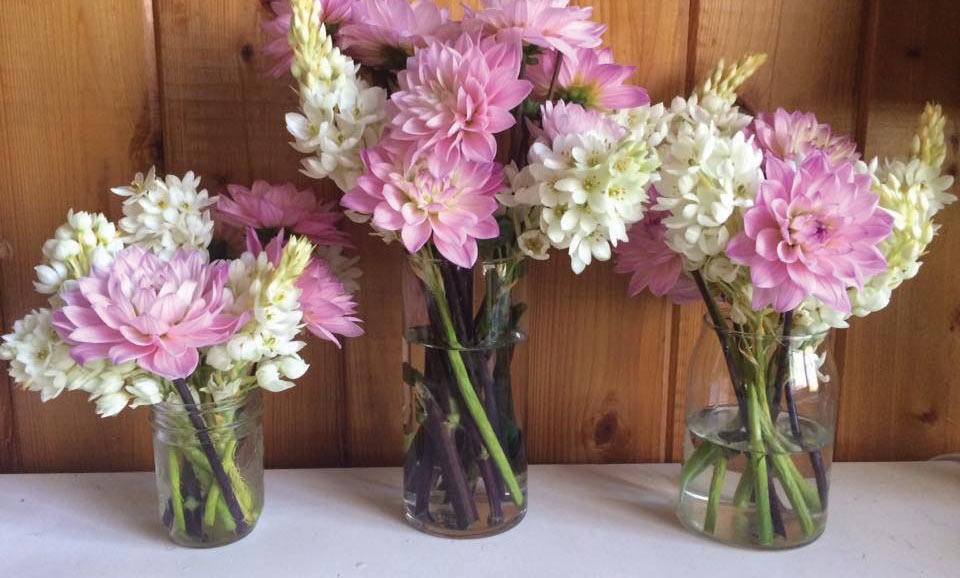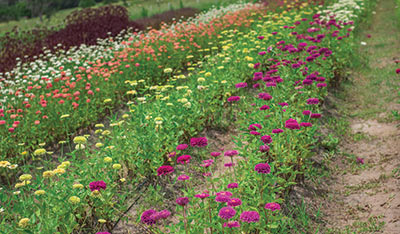
Simple, yet elegant arrangements from Yuri Hana Flower Farm.
When it comes to choosing the perfect posies for your wedding, there’s so much more than meets the eye. From the season in which you’ll wed to your budget, loads of factors will determine which blooms you’ll be carrying down the aisle. However, one aspect of floral design is often overlooked by brides: Where are your flowers coming from? According to the Association of Specialty Cut Flower Growers, almost 80% of fresh-cut flowers sold in the U.S. are grown in Columbia, Ecuador, Mexico, Netherlands and Israel. But that doesn’t have to be the case. In fact, Charleston and the surrounding area is home to several flower farmers who provide local florists with beautiful, seasonal blooms.
Why is incorporating local flowers important?

Vibrant rows of flowers from Mewbourn’s Megget farm.
Supporting our local economy and creating jobs is only the beginning when it comes to the benefits of featuring local flowers in your wedding arrangements. Locally grown flowers are much more environmentally friendly; shipping flowers around the globe and storing them properly throughout the process creates an enormous carbon footprint.
Imported flowers are cut a week or more before your wedding and spend days out of water while they travel around the world, whereas local farms cut flowers one to two days before delivering them to your florist and place them directly into water. With the latter, blooms look fresher and last longer.
Several local farmers focus on growing flowers that don’t ship well, such as dahlias, or aren’t available through wholesalers, meaning that you’re able to incorporate blooms that may not be available to you otherwise.
Many commercial flowers are bred for uniformity to ensure that they fit in shipping boxes and hold up to long commutes. That process has stripped many flowers of their natural beauty, from eliminating pretty variations in color to robbing them of their lovely scent.
Lastly, while flowers are a natural product and are always subject to changes in availability due to factors like weather or pests, imported flowers can become unavailable on short notice due to the ins and outs of the global economy. Many local florists were impacted by scarcity created by recent strikes and protests in Ecuador at the height of wedding season, and even in peaceful times, flowers can be seized by customs or damaged due to routine flight delays.
Meet our local farmers

A rainbow of zinnias from One Wild Acre.
At Yuri Hana Flower Farm, farming is a family business. One of the original flower farms in the area, Yuri Hana was established in 2005 by Charles Hendrick and is now operated by his son, Bryan. The father-son team isn’t the first to farm the plot in Conway, South Carolina; Bryan’s great-grandfather grew tobacco on this land, which has been in the family for over 100 years. Today, the Hendricks grow an extensive variety of flowers on the roughly four acres and two hoop houses that make up Yuri Hana Flower Farm. The spring is dedicated to dahlias, poppies, ranunculus, anemones, sweet peas and more, while summer and fall bring zinnia, marigolds, sunflowers and a plethora of greenery. In winter, they offer handmade holiday wreaths and garlands. Yuri Hana is also the largest supplier of smilax in the area, a type of greenery that’s commonly used to create large-scale floral installations.
Like Bryan, Laura Mewbourn’s love for farming stems from past generations. After completing the Growing New Farmers program through Lowcountry Local First, Mewbourn spent a year working on other farms while doing as much research as possible on growing cut flowers. In 2017, she purchased a home with acreage in Meggett, South Carolina, and Feast & Flora was born. Mewbourn is passionate about growing flowers via organic methods and using very few treatments for pesticides and disease. In 2020, her focus is shifting from year-round growth to a more seasonal approach tailored to peak wedding months. In the spring, Mewbourn showcases stunning Italian and butterfly ranunculus, tulips, daffodils and snap dragons, while fall features dahlias, celosia and specialty garden roses.
Another Growing New Farmers alumna, Peachey Trudell has turned her 1940s home, just minutes from downtown Charleston, into One Wild Acre. The small farm focuses on providing the community with unique flowers and the pollinators and wildlife with a safe habitat. Trudell’s property is an explosion of flowering shrubs and trees, herbs, perennials and annuals planted with design in mind; every season features a variety of colors, shapes, textures and fragrances. Aside from providing local florists with chemical-free flowers, Trudell also offers DIY options for intimate weddings and events.
How can I incorporate local flowers into my wedding?
Including local blooms is as simple as asking your florist what’s in season and expressing your desire to support our local farmers. Whether you’re looking to transport guests to a lush, romantic garden or evoke a cool, minimalist vibe, Charleston-grown flowers are sure to be the perfect complement to any wedding design.
By Lindsay C. Bishop
